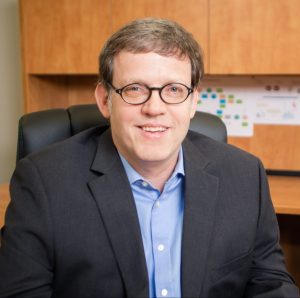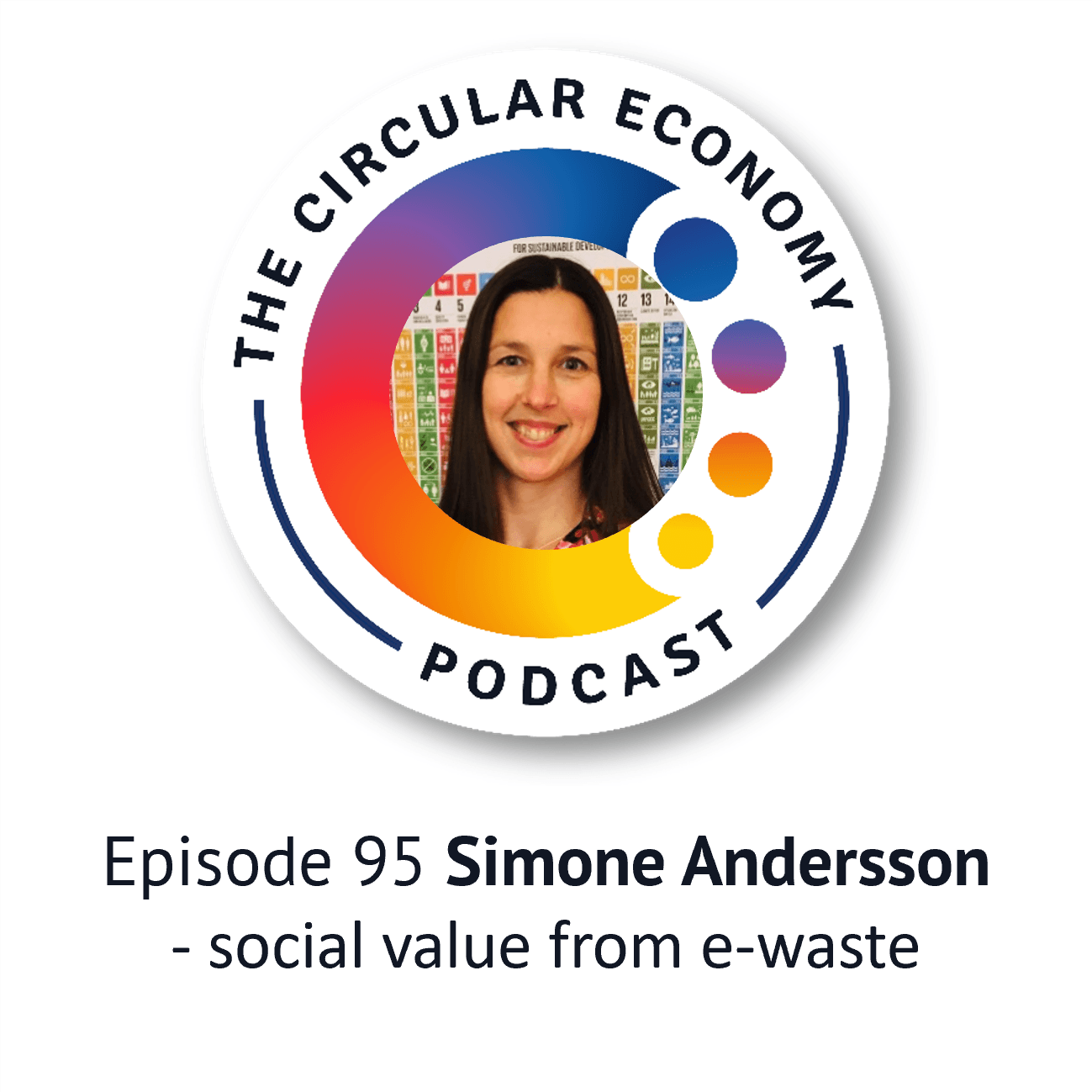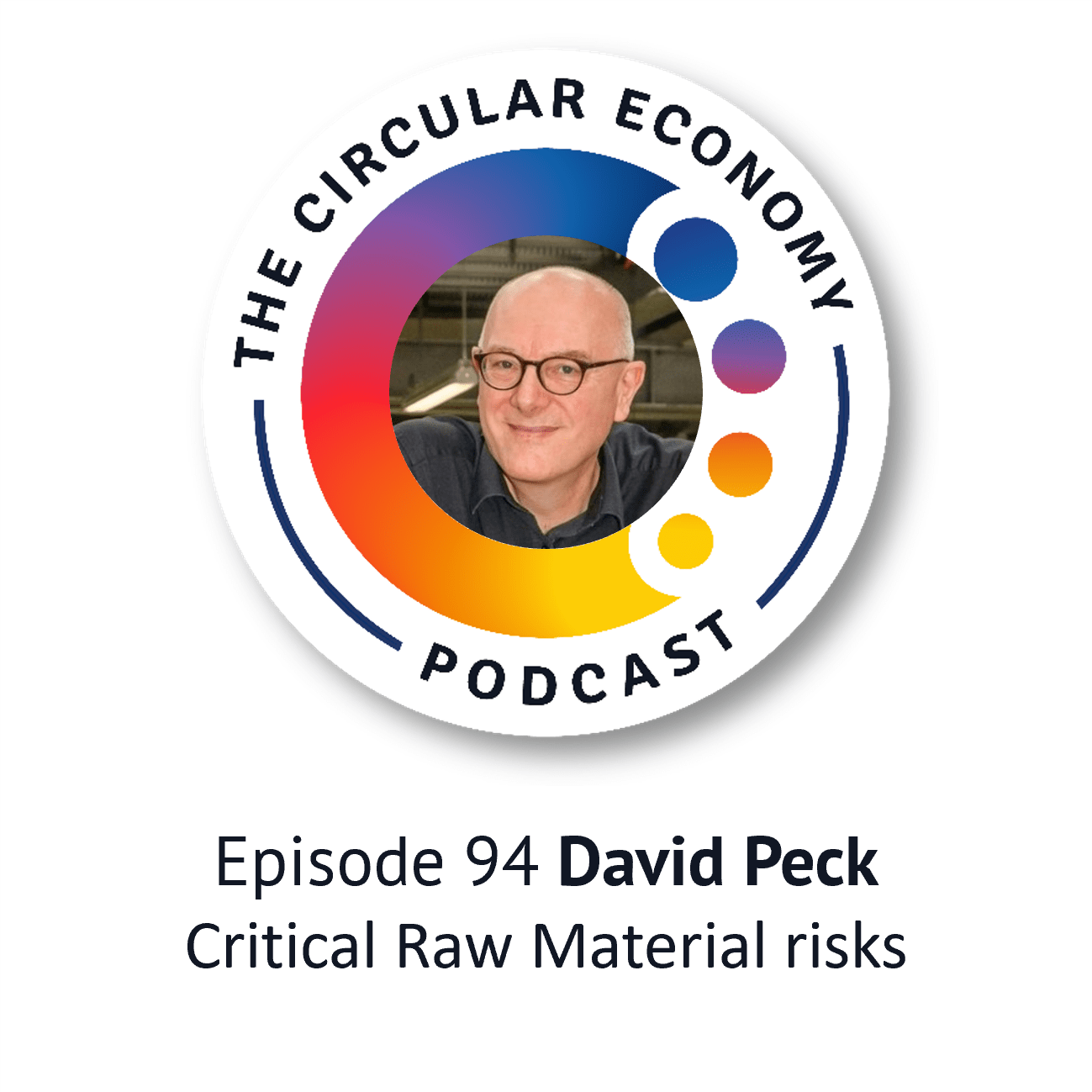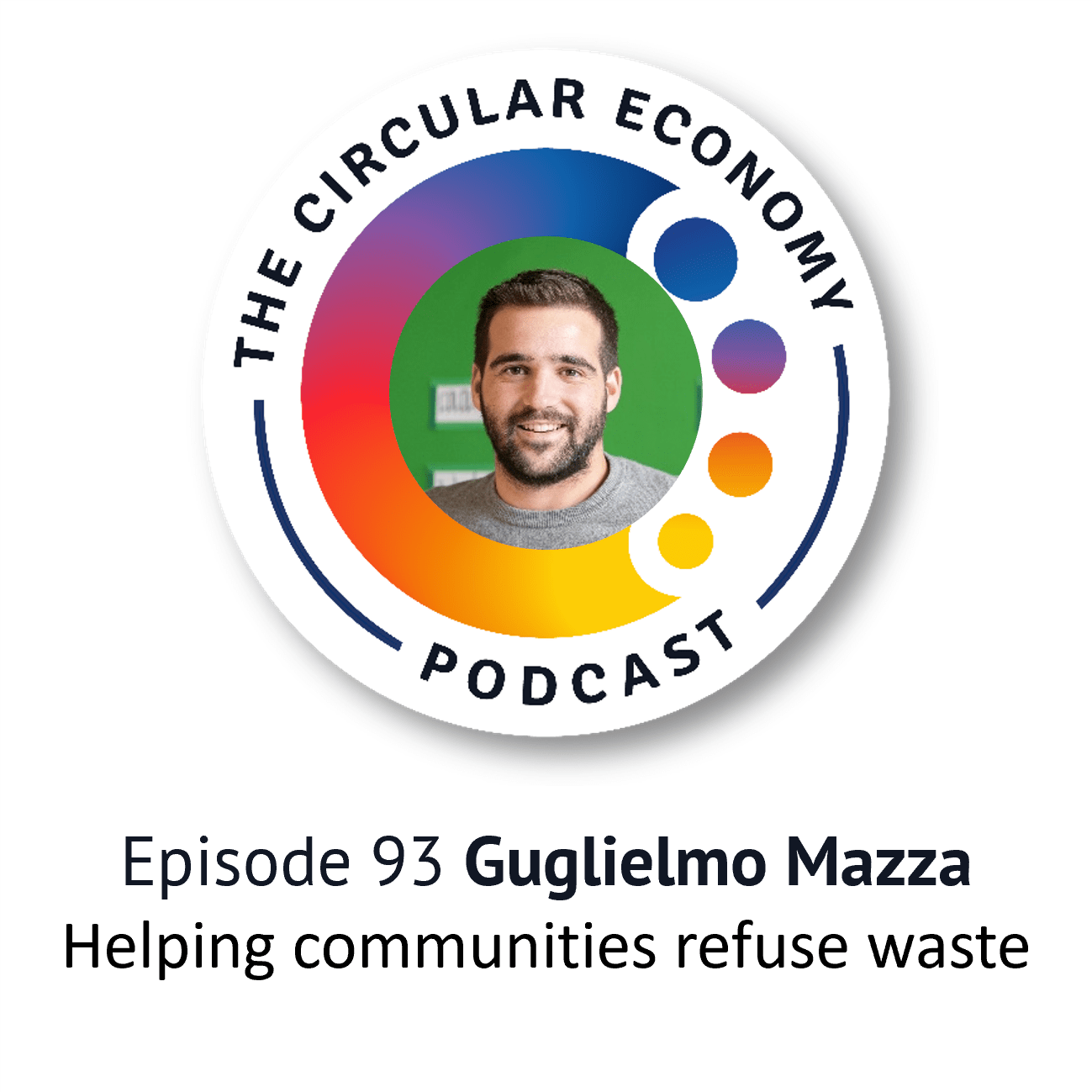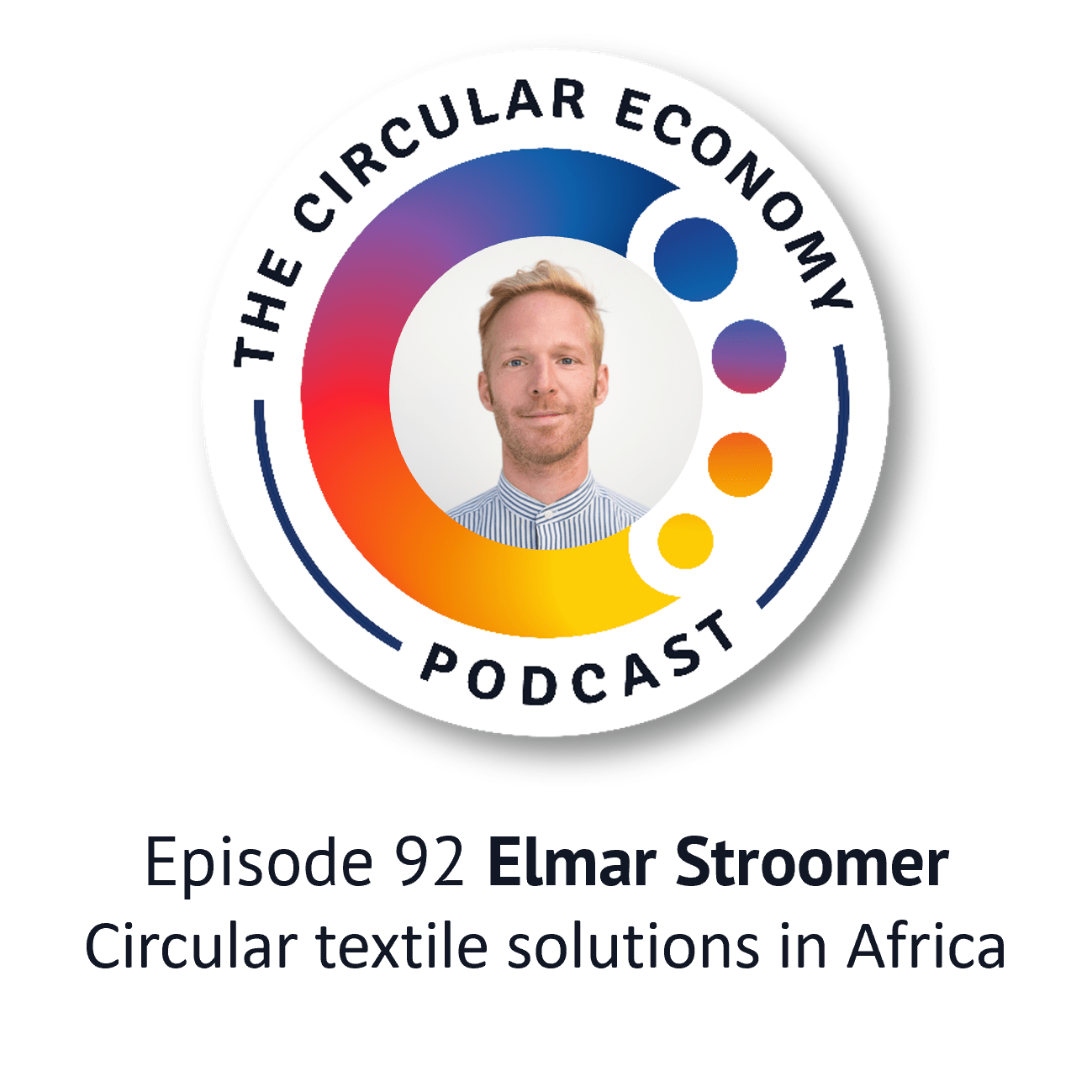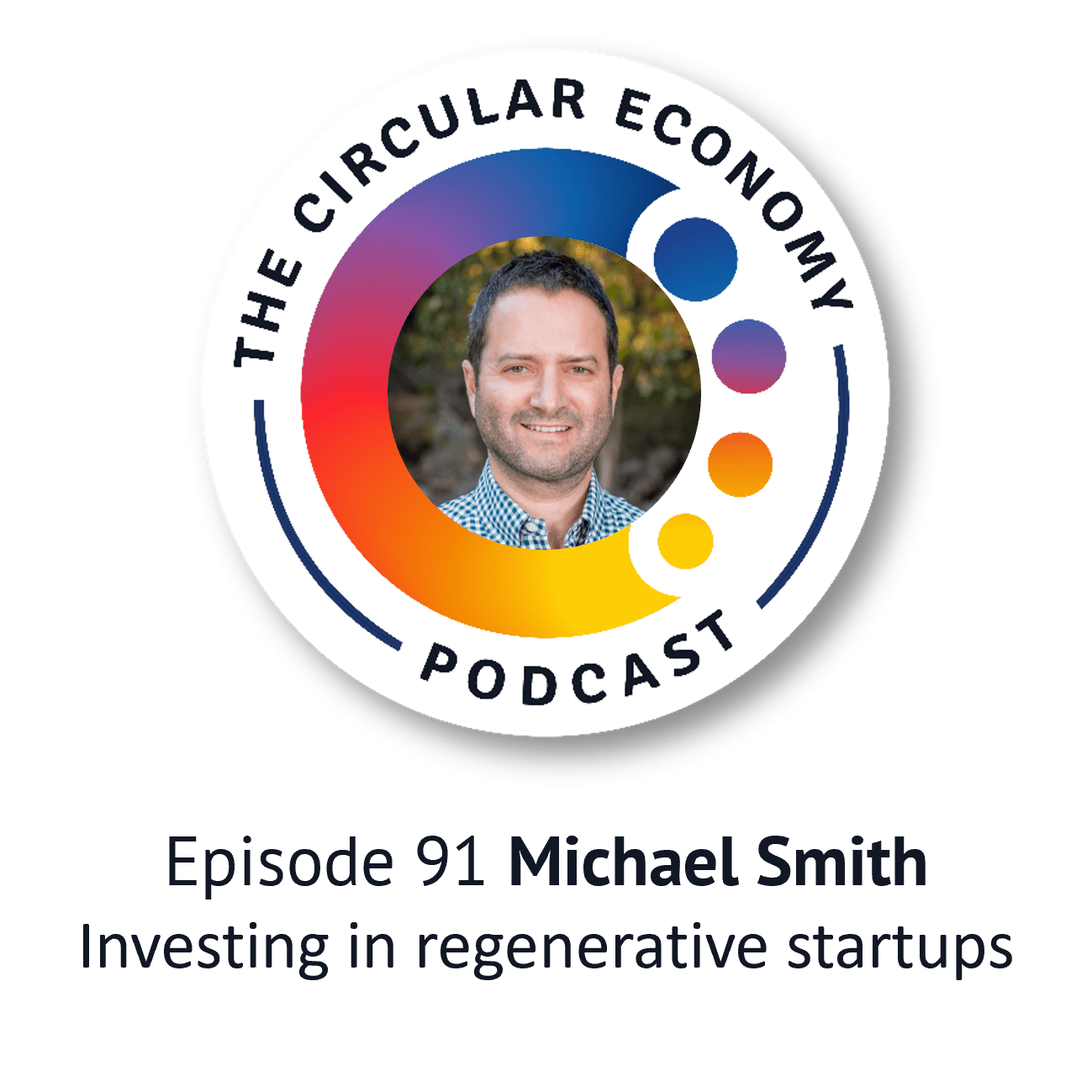Podcast: Play in new window | Download
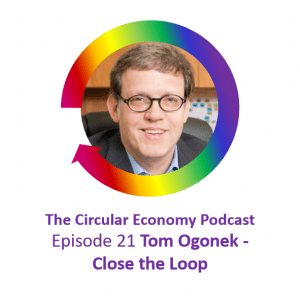 In today’s episode, I’m talking to Tom Ogonek, Co-CEO of Close the Loop Inc.
In today’s episode, I’m talking to Tom Ogonek, Co-CEO of Close the Loop Inc.
Tom joined Close the Loop in 2011 and oversees all aspects of global operations, building on a background in chemistry and manufacturing, and using his environmental industry perspective plus over 20 years of valuable operations experience to drive the business forward.
Close the Loop make it easy to take back, recover, and reuse your high value products – so they don’t end up in rivers, landfills – or on someone else’s assembly line.
Podcast host Catherine Weetman is a circular economy business advisor, workshop facilitator, speaker and writer. Her award-winning book, includes lots of practical examples and tips on getting started.
Catherine founded Rethink Global in 2013, to help businesses use circular, sustainable approaches to build a better business (and a better world).
Stay in touch for free insights and updates…
Read on for a summary of the podcast and links to the people, organisations and other resources we mention.
You can subscribe to the podcast series on iTunes, Google Podcasts, PlayerFM, Spotify, TuneIn, or search for “circular economy” in your favourite podcast app. Stay in touch to get free insights and updates, direct to your inbox…
Links we mention in the episode:
- Catherine’s blog on supply chain risk: Worried about supply-chain disruption? Why circular economy approaches are more resilient https://www.rethinkglobal.info/supply-chain-risk/
- Why reuse is #1 tool in the circular economy toolkit https://www.rethinkglobal.info/why-reuse-is-1-tool-in-circular-economy-toolkit/
- Close the Loop closetheloopusa.com 859-757-1115
- LinkedIn: https://www.linkedin.com/company/close-the-loop-inc/
- Facebook: https://www.facebook.com/ClosetheLoopUSA/
- Instagram: closetheloopinc
- Helen Lewis https://helenlewisresearch.com.au and her book Product Stewardship in Action: https://www.routledge.com/Product-Stewardship-in-Action-The-Business-Case-for-Life-cycle-Thinking/Lewis/p/book/9781783533367
- John Gagel of Lexmark http://lexmark.com/
- Conibi France https://www.conibi.fr/
- REDcycle Australia https://www.redcycle.net.au/
Tom Ogonek – Co-CEO of Close the Loop Inc.
Tom joined Close the Loop in 2011 and oversees all aspects of global operations. He has more than 20 years of valuable operations experience and environmental industry perspective and is responsible for driving continuous improvement of operating efficiencies and facility management in all global operating centers, meeting financial growth goals, and growing the business through relationships with new and existing clients. With a background in chemistry and manufacturing, Tom’s insight and experience are valuable to the company’s vision to further diversify the business.
Tom holds a bachelor’s degree in manufacturing and mechanical engineering technology from Northern Kentucky University. He is currently an adjunct professor at Cincinnati State Technical and Community College in the Center for Innovative Technology and serves on the Industry Alumni and Student Advisory Board at Northern Kentucky University’s Engineering Technology Program.
Close the Loop helps companies gain control over their sustainability processes. “We make it easy to take back, recover, and reuse your high value products – so they don’t end up in rivers, landfills – or on someone else’s assembly line.”
Transcript
Catherine (01:00):
Welcome to Episode 21. I’m recording this on the 12th of February, 2020 and the Coronavirus continues to dominate the headlines. Our thoughts are with all those affected. We’re seeing more stories of how the knock-on effects of the Coronavirus are disrupting businesses. A timely reminder of how modern supply chains are intricate, international and interlinked. My latest blog explains how circular economy approaches can mitigate against supply chain risk, avoiding the need to depend on specialist overseas resources and low-cost manufacturing.
Catherine (01:40):
In Episode 20 we looked at how to become a problem-hunter and I mentioned the brilliant book by Bec Evans called “How to Have a Happy Hustle: the complete guide to making your ideas happen.” Bec has very kindly offered a copy of the book to give away. So here’s how to win. Leave a review on iTunes or your favourite podcast app. Take a screenshot and email it to hello@rethinkglobal.info. The closing date is the 28th of February. I’ll select one of the entries at random and the winner will receive How to Have a Happy Hustle as an ebook.
In today’s episode, I’m talking to Tom Ogonek, Co CEO of Close the Loop Inc. Tom joined Close the Loop in 2011 and oversees all aspects of global operations, building on a background in chemistry and manufacturing, and using his environmental industry perspective, plus over 20 years of valuable operations experience to drive the business forward. Close the Loop make it easy to take back, recover and reuse your high-value products so they don’t end up in rivers, landfills, or on someone else’s assembly line. So Tom, welcome the Circular Economy Podcast. And where are you dialling in from today?
Tom Ogonek (03:03):
Dialling in from beautiful Hebrew in Kentucky, which is right outside of Cincinnati, Ohio in, in the USA
Catherine (03:11):
Great stuff. And thanks for joining us from there. And we’re the few hours time difference. So perhaps we can start by asking how you came to join Close the Loop. What was your background before that? Because you’ve been there quite a long time now.
Tom Ogonek (03:24):
Yeah, I started in chemistry as an approval chemist and an environmental company. It, I had gotten an interest in plastic manufacturing. It, it was a good marriage between manufacturing and my chemistry background. So I, I went, took some classes and got involved with a plastic recovery facility. And really enjoyed taking material that people saw as, as waste and turning it into useful products. Worked, worked for a bit as a manager of an injection moulding company using solely recycled plastic and found a home at Close the Loop.
Catherine (04:07):
Right? So that must’ve been in the very early days of people getting interested in turning waste back into a useful resource.
Tom Ogonek (04:14):
Yeah. You know, it started with industrial waste. Certainly, when you have post-industrial plastic that’s coming off of presses in, in the form of purge or sprues and runners, you can do a size reduction and put that right back into a product. Well now we, now we’re looking more into post-consumer. That’s more interesting for me. It’s, it’s more challenging. So that’s what I enjoy about it.
Catherine (04:38):
Great stuff. And you joined Close the Loop – and what kind of problems was Close the Loop solving back then?
Tom Ogonek (04:47):
But I started as a materials manager at Close the Loop, trying to develop the output solutions for the materials that were coming through the lines. You know, at the end of the day, Close the Loop is really about providing sustainable solutions for our partners. And in that, the highest part of the hierarchy is reuse. But there’s this back end. You have to do the recycling. You have to recover the resources – we have a zero-waste landfill commitment at Close the Loop, everything has to go somewhere. Waste to energy is a cost. It’s the, it’s the lowest outcome for a resource. Once it’s burned, it’s gone. So for us, it’s about developing that backend and that’s what I came to Close the Loop to do, which was about recovering the plastic, covering the metal, recovering the toner and, and breaking those cartridges down to base components to then reuse and other applications.
Catherine (05:49):
So, Close the Loop works with quite a few electronics manufacturers recycling and recovering their cartridges and then remaking them, most of them before they come to the end of life. Is that right?
Tom Ogonek (06:03):
That’s right. Close the Loop started about 17, 18 years ago an entrepreneur named Steve Morris out of Australia had wanted to have a competitive advantage against print consumable suppliers. And so he offered to start taking cartridges back from his customers. And in short order he ended up with a warehouse full of cartridges and said, boy, I better do something with these. So it was, it was born as a, as recycling, you know, getting these cartridges out of the mainstream, getting them out of remanufacturing to really adding value to these collection programs. I moved to the US about 11 years ago. Working with partners such as Lexmark, Xerox, HP, et cetera, all the, all the major print consumable manufacturers.
Catherine (06:56):
So do you do the logistics of the collection in-house or do you work with a range of logistics partners to get the cartridges back to your sites?
Tom Ogonek (07:05):
We, we work with a range. We, we offer that as a service, but, but we don’t own our own infrastructure for trucking, et cetera. But you know, there, there are plenty of logistics providers that do a really good job. It’s really about coordinating with them to provide us with that, that collection program. We, we do most the collection programs will help design and, and show the, our partners what are the ins and outs of certain strategies around their collection programs.
Catherine (07:38):
Mmm. And are most manufacturers are offering collection as a, as a kind of an optional facility or is it becoming more integrated as a, as a swap out, you know, you order a new, a new toner and we’ll automatically pick the old one up when we deliver the new one. How does it work?
Tom Ogonek (07:59):
It is optional. Certainly the, in the US it’s, it’s a voluntary program. In Australia, it’s a voluntary program. Europe is, is getting a bit more legislation around it. Still, you know, there’s still some it’s a different dynamic. So we have, we have different interactions with our partners globally. But in the US it’s, it’s a voluntary program, but the OEMs our partners are, are able to inspire their customers to, to then send those back.
Catherine (08:35):
Mmm. And what’s, what’s the benefit for the electronics manufacturer, the brand in getting the products back? You know, why, why did they start doing this so long ago?
Tom Ogonek (08:49):
I, I believe, I believe the manufacturers started doing this as a defensive to the remanufacturers. But since then it is developed more into how do we get value out of these. It’s, it’s expected from customers. There, it, it’s a bad PR to have cartridges sitting in landfills and, and people taking videos of that. So it, it’s become more about, Hey, we have sustainability goals, we want to engage in the circular economy. How do we keep getting more and more value out of these return programs? And that’s what Close the Loop does – we try to mind the value, show them where the value it is. It’s not just a marketing ploy but that it’s about value-added processes to engage in the circular economy.
Catherine (09:36):
Mmm. And when you, when you talk about competing against the remanufacturers, are you talking about the sort of ‘grey label’ refillable cartridge offer where, as I understand it, you know unbranded or, or kind of independent brands would get hold of high-end brand colour toner cartridges, refill them and then sell them as a lower-cost alternative. Is that what they were competing against? Sort of making sure they were taking those used cartridges off the market.
Tom Ogonek (10:14):
That’s right. So that was taking a lot of, a lot of value out of the selling the original equipment. So once people are buying a remanufactured, they’re not going to go back to the Xerox for instance in via a virgin product cause it at the end of the day it costs more. So to me from a competition standpoint, now they all work with three manufacturers. They do their own remanufacturing as well. And I think that that’s a really good story and it’s really good for the environment. So there’s nothing wrong with remanufacturer.
Catherine (10:45):
Yeah. So I guess it goes back to something I started talking about in the second edition of the book in terms of when you think about your business model, you need to be careful not to leave value on the table for somebody else. And maybe that’s what they realized they were doing. But by putting high-quality toner cartridges onto the market that were capable of being refilled several times and not collecting them back themselves, they were leaving all that value in the, in the materials and you know, the well thought-through design that made it able to be refilled. They were leaving that on the table for all these third party manufacturers to just pick up and do something with.
Tom Ogonek (11:28):
That’s right. And some of our partners really value their collection programs and the ability to remain your facture, their own cartridges, which is, which is great. We do cleaning. We’ve spent money on infrastructure to, to help them realize that but it’s, at the end of the day, it’s got to make financial sense for both parties. So it, they’re good programs there. They’re great for the environment, but they’re also good financially for customers.
Catherine (12:01):
So are you seeing an increase in uptake of returning the cartridges from customers? Is, there’s still good momentum there?
Tom Ogonek (12:11):
Again, in the US it’s a, it’s a voluntary program. So there are some of our partners are a reluctant buyer of our services. They, they want to check a box and, and so it, it’s, they’re not really pushing that other of our partners are extremely engaged and trying to get as much back. You have to do it financially sound right. It has to be, it has to be viable from a, from a financial and collection standpoint, it gets very pricey to return one cartridge through a UPS or FedEx or USPS. So and that’s where we have differences in each geography.
In Australia we’ve designed a collection program that’s, that’s multiple OEM sponsored so that the collection box sits there and they, all of the cartridges get aggregated at the collection site and then sent in bulk. When I say in bulk, you know, it’s actually multiple units versus a single unit. And some of our other partners do that as well. And we, we, we tend to talk to them and say, Hey, let’s try to optimize your collection program. If not, let’s use a retail collection site. We work with Staples, we work with Office Works in Australia and, and those, those retail sites help us with those collection programs and enable us to, to get more cartridges back.
Catherine (13:46):
Hmm. Yeah. I think these collaborative partnerships can work really well across a whole range of industries and it definitely feels like the way to go for something that you know, is, is going to be very expensive to return as a sole item compared to the value of the materials that are left in that. And you know, if you make it easy for the end-user to get something back to you then you’ve got much more chance of, of that working successfully. That’s right. Yeah. And how, how do you see that playing out in Europe? Is, is that, is there any collaboration there or is it just manufacturers doing their own thing?
Tom Ogonek (14:25):
No, there’s collaboration. In France there’s a group called Conibi, which is a consortium of OEMs that it’s, it’s a, it’s an independent company that’s owned by the OEMs and, and that’s one of our partners in Europe. So in that aggregation, then we, we have a plant outside of Antwerp. We get the material and, and help them go through discuss what, what came through, who, and sort out what, what valuable items they want back for remanufacturing or parts-harvest, et cetera.
Catherine (15:02):
Mmm, great. And what other, well, we were talking earlier about what happens to it at the end of its life. So obviously there’s a point at which, you know, it’s either become damaged or it’s been you know, refilled within an inch of its life. And it’s now, you know, finished as a toner cartridge. What happens to them then?
Tom Ogonek (15:24):
Yeah, so that’s, that’s what recycling is. One of the services we provide we’ve, we’ve engineered equipment to handle this, this material, and we keep working on, on our engineering to create more efficient processes to, to recover the products. It’s all about pulling out the base components of a cartridge. There’s plastics, there’s metals, there’s rubbers, there’s toner there’s ink depending on which, where we go and, and with all of that, then we take those base components. I’m trying to try to find the highest value outcome. So with, with that, we’ve, for instance, we’ve taken ink and we’ve worked with a partner to create a flexographic ink. We funded that solution. But yeah, it’s a good outcome for ink as opposed to just trying to use a flocking room, drop out the salads and then sewer it. So it’s, that’s to us, it’s a much better outcome because it’s getting into a reuse application.
Tom Ogonek (16:27):
And we do that with all the components. The plastic is, is our partners are really valuing the plastic to go back into their, into their units. So we are working hard to get a high clean flake or, or plastic that then can go back into their, their manufacturing lines. We also have worked with toner. Toner has is one of the reasons we exist. It’s a combustible dust. It has inherent risks with it. And we’ve developed over the course of years and it’s taken many years and it’s taken a lot of collaboration with our partner downer in Australia and asphalt additive that it’s not about a horizontal landfill. If it doesn’t add value, it’s not worth doing.
So it’s actually adding value. It’s replacing a raw asphalt or raw bitumen. It’s, it’s creating, it’s changing the chemistry. So it’s, it’s adding imparting qualities that are good. And in this additive development, we’ve also incorporated soft plastics or films. So we work with a collection group called REDcycle in Australia that works with Woolworth and et cetera. Many partners in Australia. And then as you can see, it takes a lot of collaboration to bring all this material together and Close the Loop works as the intermediary to help develop the real-world sustainable solutions for these problems.
Catherine (18:05):
So you’re really at the centre of a big ecosystem of suppliers and partners, you know, at every stage of the plastic and toner supply chain. That’s right.
Tom Ogonek (18:17):
Yeah. It’s really about collaboration. Without it. You need a commitment from the producers. You need a commitment from consumers to engage in returning. You need a commitment from processors to solve the problems. And then a commitment back from the manufacturers to say, Hey, I’ll, I’ll buy the material back or I’ll reuse the material and find the highest value we can.
Catherine (18:41):
Hmm. And are you finding that some of the brands are starting to ask you about how they can make the toner cartridge easier to recycle or easier to disassemble at the end of life? Have you ever had any kind of, you know, improved design breakthroughs from, from the work
Tom Ogonek (18:59):
We, we have, we are not directly engaged in, in the design of cartridges. But we definitely discuss how to recycle them, how to recycle them more efficiently. What design changes could be made? That’s something that, that we have been in discussions with since we’ve started going through the recycling process. How do you make this easier or make it easier to recover? Because at the end of the day, you want to be able to recover this, this product and not have it hit landfill, which is where our commitment waste energy we use as a last resort. So we try to minimize that as much as possible because once you, once you burn that, there’s nothing left. So it’s really about how do we keep plastic in plastic? How do we keep metal and metal, etc.
Catherine (19:49):
Yeah, and I guess more and more, I’m just thinking about that. That’s a really good, good quote. Once you’ve, once you’ve burnt it as it’s gone, that’s kind of, you know, whilst I S I see quite often energy from waste build as a circular economy solution and you know, I, I don’t think it is, it’s as you say, it should be the absolute last resort and it should be something, a temporary solution so we can find something, a better way to, to kind of keep it, keep it properly in the loop. But that vision of, you know, you burn it and then that’s it. It’s gone. Is, is more likely to anchor that at, at you know, in people’s mind that it’s, it’s not, it’s not a circular solution cause it’s, you’ve, you just got rid of it.
So I mean, do you see big differences in the designs between, so if, if a company has really thought about how are we going to get the value back out of this cartridge at the end of its life? And we’ve designed it with that in mind, so it’s easy to take apart the, all the materials have got value and so on. Do you see a big difference between that approach and then a company that’s a bit more reluctant and is, is kind of ticking boxes and they haven’t really put much thought into the design of the cartridge itself?
Tom Ogonek (21:07):
Well, it’s a competitive market, right? So, you know, when one change happens, everybody follows pretty quickly.
Catherine (21:14):
So they all look at what each other. Yeah,
Tom Ogonek (21:16):
Yeah, absolutely. And, and so there’s other, there’s other drivers too. So the cartridges could be higher print volume for instance, as you want to go buy a cartridge, you don’t want to have to replace it as much or you know, whatever the drivers are for design change. In, in this industry there are many. And recyclability is one of them, certainly recovery or re even remanufacturers. So you know, there are some of our partners do a very good job of looking at it and saying, Hey, if I bring this back and how many uses can I get? And we have, we have a particular partner that that has a prescribed number of times that they can, they can reuse a cartridge and it gets marked and we look at them and we see them and, and it’s a, it’s a really great story because that’s the best use. I mean it’s, it’s for its intended use, right, is to take that, take that unit and take it back into its intended use. So it’s good.
Catherine (22:16):
Yeah. Great stuff. And what about the next phases for Close the Loop? What, what plans have you got for maybe other products or other, other markets, countries, or what’s next?
Tom Ogonek (22:27):
Well, we, we’ve been under the radar for the last 17 years. Working with our, our partners. I, I think the print market has been ahead of the game in the circular economy. Not only in the consumables but also in their hardware. And for us, we, we have experienced in driving real-world solutions, large sustainable solutions. We’ve, we’ve done a small pilot program in Australia in cosmetics the, and we want to take that globally and it’s really about recovering the plastics, etc. So cosmetics is mostly packaging. I learned more about cosmetics than I want it to, but that’s okay. And it’s a, it’s about bringing, bringing the value back in those, those things that get discarded.
So there’s a lot of reasons that a cosmetic company would want to engage with Close the Loop, which could be a brand protection. Instead of having someone grab that packaging and repackage their own material in it and sell it at that high premium to actually getting the plastic back when there’s a lot of work being done by some cosmetic companies that say, Hey, we really are engaged in the circular economy. We want to bring that plastic back into the manufacturing and bring those parts back in and, and in the supply chain.
Catherine (23:54):
Hmm. Wow. I had not thought of that. I mean, I, you know, I’ve been reading quite a bit about the use of technology and so on to try and prove authenticity for say, high-end fashion and for high-end perfumes and cosmetics. But I was imagining just somebody doing me two look-alike products, not kind of getting hold of the packaging and then just refilling it. Yeah, I guess, I guess as soon as you start to think of, think about it, you think, well, if somebody could do that for toner cartridges and you know, sell them under a different label, why could you not do it and, and fake it as, as the real thing. That’s right.
Tom Ogonek (24:34):
And that, so we lower the liability then, for our partners. It’s about taking that out of the stream and not allowing that to get into, into other markets.
Catherine (24:45):
Hmm. So how are you, how are you getting the packaging back from the consumer? Is there a sort of a, a postal option, you know, like they used to be with home print cartridges where with every new inkjet cartridge or whatever for, I think mine used to be HP, there was an envelope, so you could either post it straight back to HP or there were also charities that would you know, take them from you. How does it get back?
Tom Ogonek (25:11):
So again, that’s a, it’s a pilot program in Australia and yeah, it’s postal and or the charities that, that aggregate and come back to Close the Loop. So, you know, as we develop programs, we have to, we have to design what makes, what makes the most sense. Certainly storefront collection is, is always a good option because you’ve got aggregation there, you’ve got a point of purchase it increases foot traffic as from a retail space. That’s a really good story if you can, if you can offer that service it works with cartridges because a lot of people carry their empty cartridges in and, and say, ‘I’d need to replace this cartridge’ and then they can put it into a collection point and you know, pick the new one off the shelf, which that’s it. That’s a great outcome. Those are, those are programs that we, we will develop over the, over the next 10 years. And, and find those parallel programs that, that fit into Close the Loop.
Catherine (26:17):
Yeah. And I guess another option may be reverse vending machines? I don’t know if you’ve got those yet in the, in the States. There are a few well more than a few companies doing them across Europe for things like batteries and even plastic bottles and so on where you, you know, it just like a vending machine for sweets or drinks or you put your, put your whatever back in, you know, your empty lipstick container or something. And because of all the machine learning developments, it can recognize very quickly a wide range of products – recognize whether it’s something that you were supposed to put in the machine and, and are you going to be rewarded for it. And then if you put your card in, you can be rewarded with, you know, money off the next purchase.
Tom Ogonek (27:05):
Yeah. Cell phones, they do that, they do that with cell phones widespread. So you know, cell phones are a good remanufactured item as well. There’s a lot of value in an old cell phone. Not only is there value in remanufacturing it, but there’s also value in the precious metals and plastics that can come out of those cell phones. It is a really collected, highly collected item at least, you know, globally actually. Cause a lot of those get remanufactured and end up in other markets.
Catherine (27:39):
Hmm. So, well, I think that the cosmetics thing sounds really interesting because as you say, there is an awful lot of packaging around cosmetic. So trying to get some of that back into a high-value loop would be really good.
Tom Ogonek (27:52):
Yeah. There’s a lot of products that will benefit from these processes and we have to, we as, as consumers, we as producers, we as processors have to be committed to the recovery of this. These resources end up in landfill. They’re not coming back. But if you take a water filter, for instance, water filter has carbon black and it’s got a plastic shell that’s highly recoverable. The carbon can be reconstituted, the plastic can be pulled out and remanufactured. We need to get awareness. We need people to be committed to those endeavours so that the producers, the large producers have to embrace the circular economy. They have to say we’re committed to it, and then we have to have, you know, everybody collaborating in order to get that result.
Catherine (28:53):
Mmm. Yeah, I agree. Yeah. And I think we’re starting to see some traction around that with things like the Loop packaging system, that Terracycle is putting in. The, you know, big brands are getting behind that and seeing a way to engage, engage directly with the end-user, and put more value into the packaging because it can come back and be refilled over and over again. So yeah, that was great. And so Tom, what would your top tip be for anybody thinking about taking their business more circular or doing a circular startup right now?
Tom Ogonek (29:31):
It’s an interesting market. You have to, you have to listen to your partners and, and make sure you’re, you’re filling their needs and not what you think is best. Because at the end of the day, you’re, if it’s not good financially, it’s not gonna be sustainable. So in that, it all takes collaboration. Nobody can do this on an island. We all have to work together. There’s a lot of good work being done on community levels, on global levels manufacturing levels that that needs to be learned. We need to learn from each other and continue to develop the right processes and recovery programs.
Catherine (30:14):
Mmm, great. And it sounds like that’s, you know, fundamental in the approach that Close the Loop takes with its multiple partners all in the supply chain. Fantastic. And do you have a favourite circular economy example or somebody else that you’d recommend as a guest for a future podcast?
Tom Ogonek (30:33):
You know, one of our, our partners has been Lexmark over the years and they have, they have really pushed the envelope to make sure they, they engage in the circular economy. There’s a gentleman named John Gagill that we’ve worked with over the years. He really likes these high outcomes. And I say that because he’s, he’s an hour from us, in the South. So, so we’ve been fortunate enough to work with him over the years and, and that’s in our industry. We’ve, we’ve also, there’s a woman named Helen Lewis from Australia and she’s written a book Product Stewardship in Action, I believe is the name of it. And she’s done a case study on Close the Loop. She’s been a good advocate of what we do. And since her book came out, we’ve developed even, even more processes and more, more outcomes for the circular economy.
Tom Ogonek (31:37):
You know, the biggest development we’ve had over the last few years has been the use of the grocery bags that the soft plastics coming in, in the asphalt added in. So it’s a, it’s a really good story. It’s a value-added story. The material being a replacement for asphalt that’s been dug out of the ground, et cetera. Really and it’s recyclable, so it’s endlessly recyclable as asphalt is on, so as a road gets ripped up, it goes back into a road. Which is a really good story. It’s got a good value-added and that’s really what Close the Loop has to do.
Catherine (32:19):
Yeah, that sounds, that sounds good. So I’ll look her up as well. Tom, how can people find out more about Close the Loop and get in touch?
Tom Ogonek (32:27):
They can find us on the web at www.closetheloop.usa.com or they can find us on LinkedIn. We have three geographies. There are websites for each, so there’s one in Europe, one in Australia and then the one here in the US
Catherine (32:44):
Great stuff, and I’ll put those links in the show notes as well. So Tom, thank you very much for telling us all about Close the Loop and we wish you the best of luck with the next phase and look forward seeing lots more innovations to bring packaging and other products back into the loop in the future.
Tom Ogonek (33:01):
Good. Appreciate it. Thank you for taking the time to talk to me.
Catherine (33:04):
Thanks Tom.
Want to find out more about the circular economy?
If you’d like to learn more about the circular economy and how it could help your business, why not listen to Episode 1, or read our guide: What is the Circular Economy?
To go deeper, you could buy Catherine’s book, A Circular Economy Handbook for Business and Supply Chains This comprehensive guide uses a bottom-up, practical approach. It includes lots of real examples from around the world, to help you really ‘get’ the circular economy. Even better, you’ll be inspired with ideas to make your own business more competitive, resilient and sustainable.
Please let us know what you think of the podcast – and we’d love it if you could leave us a review on iTunes, or wherever you find your podcasts. Or send us a Tweet: @Rethink _Global.
Podcast music
Thanks to Belinda O’Hooley and Heidi Tidow, otherwise known as the brilliant, inventive and generous folk duo, O’Hooley & Tidow for allowing me to use the instrumentals from the live version of Summat’s Brewin’ as music for the podcast. You can find the whole track (inspired by the Copper Family song “Oh Good Ale”) on their album, also called Summat’s Brewin’. Or, follow them on Twitter.
